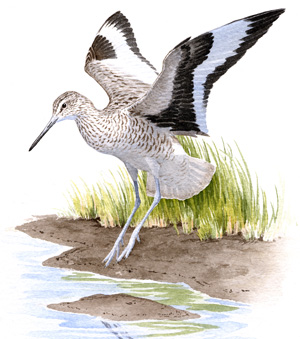Find a Bird
Willet
Tringa semipalmata

Local and strongly increasing
“The sight of a Crow, a Turkey Buzzard, a quadruped of any kind, and more especially of a gunner, at once excites the greatest alarm; and, rising on wing, they fly above and around you at a considerable distance, vociferating their anger with great vehemence, and continually endeavoring to allure you away from the spot where their treasure is concealed.” – John James Audubon, Birds of America
As unmistakable in flight as it is inconspicuous at rest, the Willet with its boldly patterned wings and its rolling cries of pill-will-willet!,heralds the coming of spring at the seashore. This species breeds farther south than any other sandpiper in North America, and its breeding range once actually stretched from the Gulf of Mexico all the way to Atlantic Canada. Because Willets suffer the misfortune of having tasty eggs and meat, they faced serious challenges from humanity in the not-too-distant past. In fact, the return of the Willet as a breeding species to Massachusetts may at one time have seemed like little more than a dream, but its recovery in the Bay State has more than proven its mettle.
Historic Status
If some of the great ornithologists of a century ago were around today, they would no doubt be amazed to see the Willet at all, let alone find it breeding in Massachusetts. Market gunners seeking to retrieve its eggs shot the species into extirpation from Massachusetts during the late 1800s, driving it as far south as Virginia, from which point its range once stretched as far north as Nova Scotia. John James Audubon noted that it historically bred in the New Bedford area, and another reporter found a nest on Muskeget Island in 1870 (Howe & Allen 1901). Edward Howe Forbush lamented the Willet’s impending demise in the 1920s, when he wrote, “Unless the most stringent measures for its protection are taken it will disappear as a breeder from the entire Atlantic coast” (Forbush 1925).
Atlas 1 Distribution
With the Migratory Bird Treaty Act of 1918 firmly in place, the Willet showed its tenacious spirit by resettling the Bay State during Atlas 1, despite receiving no direct human assistance. Two Probable blocks in Essex County and another near Plymouth beach comprised the entirety of the Coastal Plains breeding population. The only Confirmed record in Atlas 1 came from a pair of Willets at Monomoy Island, in the Cape Cod and Islands ecoregion. Not surprisingly, there were no breeding records of this exclusively maritime shorebird anywhere away from the coast.
Atlas 2 Distribution and Change
Along with the Piping Plover and the American Oystercatcher, the Willet completes a suite of coastal nesting shorebirds in Massachusetts that have shown a strong recovery of their historic breeding range since Atlas 1. The cessation of direct persecution from hunting set the Willet on the road to recovery, and because of its marsh-nesting behavior instead of beach-nesting, its direct conflict with humans was minimized. Willets expanded into at least 82 new blocks in Atlas 2, not surprisingly all along the coast. In most of these blocks there are multiple breeding pairs, so the scale of recovery is even greater than the increase in nesting distribution suggests.
Atlas 1 Map

Atlas 2 Map

Atlas Change Map

Ecoregion Data
Atlas 1 | Atlas 2 | Change | ||||||
Ecoregion | # Blocks | % Blocks | % of Range | # Blocks | % Blocks | % of Range | Change in # Blocks | Change in % Blocks |
Taconic Mountains | 0 | 0.0 | 0.0 | 0 | 0.0 | 0.0 | 0 | 0.0 |
Marble Valleys/Housatonic Valley | 0 | 0.0 | 0.0 | 0 | 0.0 | 0.0 | 0 | 0.0 |
Berkshire Highlands | 0 | 0.0 | 0.0 | 0 | 0.0 | 0.0 | 0 | 0.0 |
Lower Berkshire Hills | 0 | 0.0 | 0.0 | 0 | 0.0 | 0.0 | 0 | 0.0 |
Vermont Piedmont | 0 | 0.0 | 0.0 | 0 | 0.0 | 0.0 | 0 | 0.0 |
Berkshire Transition | 0 | 0.0 | 0.0 | 0 | 0.0 | 0.0 | 0 | 0.0 |
Connecticut River Valley | 0 | 0.0 | 0.0 | 0 | 0.0 | 0.0 | 0 | 0.0 |
Worcester Plateau | 0 | 0.0 | 0.0 | 0 | 0.0 | 0.0 | 0 | 0.0 |
Lower Worcester Plateau | 0 | 0.0 | 0.0 | 0 | 0.0 | 0.0 | 0 | 0.0 |
S. New England Coastal Plains and Hills | 3 | 1.1 | 75.0 | 19 | 6.7 | 19.6 | 11 | 4.9 |
Boston Basin | 0 | 0.0 | 0.0 | 5 | 8.9 | 5.2 | 4 | 7.3 |
Bristol and Narragansett Lowlands | 0 | 0.0 | 0.0 | 15 | 13.2 | 15.5 | 14 | 13.9 |
Cape Cod and Islands | 1 | 0.7 | 25.0 | 58 | 40.3 | 59.8 | 53 | 44.2 |
Statewide Total | 4 | 0.4 | 100.0 | 97 | 9.4 | 100.0 | 82 | 9.9 |
Notes
Despite impressive recovery in Massachusetts, the Willet shows a significant decreasing Breeding Bird Survey trend in the Eastern US overall.



